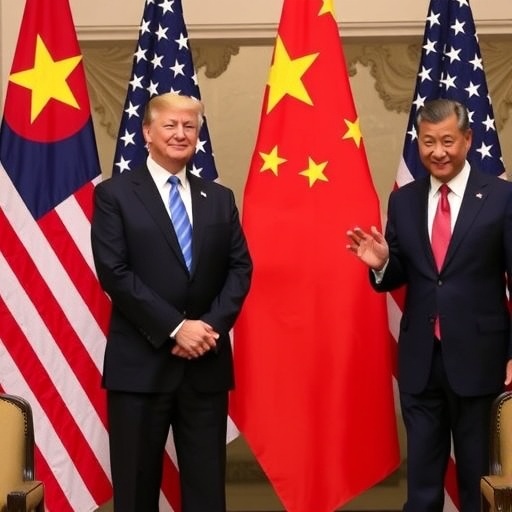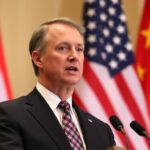Treasury Secretary Scott Bessent Unveils Hopeful Framework in Tense U.S.-China Trade Negotiations
In a surprising turn amid escalating global tensions, Treasury Secretary Scott Bessent announced on Thursday a promising framework for U.S.-China trade talks that could prevent a fresh wave of tariffs and foster unprecedented cooperation on the fentanyl crisis. Speaking at a press conference in Washington D.C., Bessent described the developments as a “significant step forward,” emphasizing how the agreement aligns with President Trump’s vision for fair trade and national security. This comes just weeks before President Trump is set to meet with Chinese President Xi Jinping, potentially reshaping the bilateral relationship that has defined much of the past decade.
- Treasury Secretary Scott Bessent Unveils Hopeful Framework in Tense U.S.-China Trade Negotiations
- Averting Tariffs: How the Framework Shields U.S. Economy from Trade War Escalation
- China’s Pledge on Fentanyl Precursors: A Game-Changer in the Opioid Battle
- Trump’s Upcoming Summit with Xi: Stakes High for Global Economic Stability
- Long-Term Implications: Reshaping U.S.-China Ties and Beyond
The announcement marks a pivotal moment in U.S.-China trade relations, which have been strained by intellectual property disputes, supply chain vulnerabilities, and the ongoing opioid epidemic fueled by Chinese precursor chemicals. Bessent, a Wall Street veteran appointed by Trump to navigate these complex waters, highlighted the framework’s role in de-escalating potential economic conflicts. “We’ve laid the groundwork for mutual benefits,” Bessent stated, underscoring the administration’s commitment to protecting American workers while addressing humanitarian concerns.
According to U.S. Trade Representative data, the U.S.-China trade deficit reached $367 billion in 2023, a figure that has long irked policymakers in Washington. The new framework aims to address imbalances through targeted measures, avoiding the broad tariffs that Trump imposed during his first term, which affected over $360 billion in Chinese goods and led to retaliatory actions costing U.S. farmers billions. Economists estimate that those earlier tariffs added $80 billion annually to American household costs, making this aversion a welcome relief for consumers and businesses alike.
Averting Tariffs: How the Framework Shields U.S. Economy from Trade War Escalation
At the heart of the U.S.-China trade breakthrough is the commitment to avert new tariffs, a move that Bessent credits to intensive bilateral discussions over the past six months. Under the proposed framework, both nations have agreed to a 90-day moratorium on tariff impositions, allowing time for deeper negotiations on market access and investment rules. This pause is particularly crucial as U.S. manufacturers, from semiconductors to automobiles, grapple with supply chain disruptions exacerbated by the COVID-19 pandemic and geopolitical frictions.
Bessent detailed how the agreement includes provisions for China to ease restrictions on American agricultural exports, potentially boosting U.S. soybean and pork shipments that plummeted 74% and 52% respectively after the 2018 trade war. “Tariffs are a blunt instrument; this framework offers precision,” Bessent remarked, quoting internal memos from the Treasury Department that project up to $50 billion in annual savings for U.S. exporters if implemented fully.
Industry leaders have reacted positively. The National Association of Manufacturers praised the development, with CEO Jay Timmons stating, “This averts a disaster for our members who rely on stable U.S.-China trade flows.” However, skeptics like Senator Marco Rubio (R-FL) caution that any deal must include enforceable mechanisms to prevent China from subsidizing state-owned enterprises, a practice that distorts global markets and disadvantages U.S. firms.
Looking at historical context, Trump’s first-term tariffs under Section 301 of the Trade Act of 1974 targeted unfair practices, leading to Phase One of the 2020 deal where China pledged $200 billion in purchases—though it fell short by 40%. The current framework builds on that, incorporating digital trade safeguards and intellectual property protections, areas where U.S. losses exceed $600 billion yearly according to the U.S. International Trade Commission.
China’s Pledge on Fentanyl Precursors: A Game-Changer in the Opioid Battle
Perhaps the most emotionally resonant aspect of the announcement is China’s cooperation on fentanyl precursor chemicals, a long-standing U.S. demand amid the deadliest drug crisis in American history. Bessent revealed that Beijing has committed to stricter export controls and joint enforcement operations targeting the synthetic opioids ravaging communities across the U.S. This includes real-time data sharing on chemical shipments and penalties for non-compliant firms, addressing a key Trump administration priority.
The fentanyl epidemic has claimed over 100,000 lives annually in the U.S., with the CDC reporting a 22% spike in overdose deaths in 2023 alone. Much of the supply chain originates in China, where precursor chemicals like 4-AP and NPP are legally produced but often diverted to illicit markets. “Securing this cooperation is a lifeline for American families,” Bessent said, echoing Trump’s repeated calls for action during campaign rallies.
Under the framework, China will establish a dedicated task force with U.S. counterparts, modeled after successful anti-trafficking initiatives with Mexico. Experts from the RAND Corporation estimate this could reduce fentanyl inflows by 30-50% within two years, potentially saving 30,000 lives. Dr. Nora Volkow, director of the National Institute on Drug Abuse, welcomed the news: “International collaboration is essential; this framework represents a vital step toward disrupting the supply chain.”
Past efforts have yielded mixed results. In 2019, China scheduled fentanyl as a controlled substance following Trump’s direct appeal to Xi, but enforcement lagged, with U.S. Customs and Border Protection seizing 27,000 pounds of the drug in fiscal year 2023—up from 4,000 pounds in 2017. The new agreement introduces verifiable metrics, such as annual audits and technology transfers for detection, to ensure accountability.
Trump’s Upcoming Summit with Xi: Stakes High for Global Economic Stability
As President Trump gears up for his meeting with President Xi later this month in Singapore, the eyes of the world are on how this U.S.-China trade framework will evolve. Bessent, who will accompany Trump, described the summit as a “make-or-break opportunity” to formalize commitments and address thornier issues like technology transfers and currency manipulation. The venue, a neutral ground, signals both sides’ intent to prioritize dialogue over confrontation.
Trump’s approach has always blended tough rhetoric with deal-making prowess. During his first presidency, the 2018-2019 trade war pressured China into concessions, but it also strained alliances and fueled inflation. Now, with midterm elections looming and inflation at 3.2% per the latest Bureau of Labor Statistics report, Trump seeks a win that bolsters his ‘America First’ agenda without alienating key voters in manufacturing states like Ohio and Pennsylvania.
Geopolitical analysts point to broader implications. The framework could stabilize semiconductor supplies, critical for U.S. tech giants like Apple and Intel, which source 60% of components from Asia. Yet, challenges remain: China’s Belt and Road Initiative continues to expand influence in Africa and Latin America, prompting U.S. countermeasures like the CHIPS Act, which allocated $52 billion for domestic production.
International reactions are pouring in. EU Trade Commissioner Valdis Dombrovskis noted that a stable U.S.-China trade environment would benefit global growth, projected at 3% by the IMF for 2024. Meanwhile, critics in Beijing’s state media have tempered enthusiasm, warning against U.S. “protectionism,” though official channels express willingness to engage.
Long-Term Implications: Reshaping U.S.-China Ties and Beyond
Beyond the immediate wins on tariffs and fentanyl, this framework signals a potential thaw in U.S.-China relations, with ripple effects across global markets. Bessent projected that successful implementation could add 0.5% to U.S. GDP growth by 2025, per Treasury models, while curbing the $1 trillion annual cost of the opioid crisis through reduced healthcare and law enforcement expenditures.
Looking ahead, the next steps involve congressional oversight, with the House Ways and Means Committee scheduling hearings next week to scrutinize the deal’s fine print. Environmental groups are pushing for inclusions on green tech cooperation, given China’s dominance in solar panels and batteries—sectors vital to Trump’s energy independence goals.
For American businesses, the outlook is cautiously optimistic. A survey by the U.S. Chamber of Commerce found 68% of executives believe the framework will enhance predictability, though 45% worry about enforcement gaps. As Trump and Xi convene, the world watches: will this be the start of a new era of pragmatic partnership, or merely a temporary truce in an enduring rivalry?
In the fentanyl realm, pilot programs for joint interdiction could expand to other synthetics like xylazine, dubbed the ‘zombie drug’ for its gruesome effects. Public health advocates, including former FDA Commissioner Scott Gottlieb, urge sustained funding: “This is progress, but vigilance is key to turning the tide.”
Ultimately, the framework’s success hinges on execution. With Bessent at the helm, the Trump administration aims to deliver tangible results—lower costs for families, safer streets, and a leveled playing field for U.S. innovation. As negotiations intensify, one thing is clear: the U.S.-China trade dynamic remains the linchpin of global stability.









